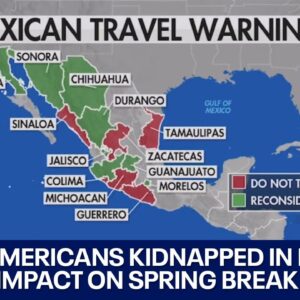Concerns Over Spring Break Travel to Mexico Amid Heightened Kidnapping and Killing
Travel Advisories and Student Reactions
With the spring holiday season in full swing, many US students are heading to Mexico despite warnings from US officials. The US State Department has issued a level 4 travel advisory – the highest level – for six Mexican states, including Tamaulipas, located south of Brownsville, Texas. Despite the heightened concern for safety, some college students remain undeterred.
Warnings and Kidnappings
The travel warnings were first issued last year, and then reissued on the same day that four Americans were kidnapped in Matamoros, two of which are now dead. Richard Sindelar, a former State Department official and University of St. Thomas professor, advised that the level 4 warning should be taken seriously, especially by those considering travel to Matamoros. The high risk for that particular city is due to two cartels currently locked in a cartel war.
Ignoring the Advisory and Remaining Vigilant
Sindelar offers advice for those choosing to disregard the travel advisory or for those traveling to cities with a level 2 warning: stay vigilant and be aware of your surroundings. If you believe you are being followed, pay attention and alter your path or find somewhere safe to go, such as a hotel or store.
In addition, the State Department advises travelers to refrain from wearing or carrying expensive jewelry that may attract unwanted attention.
Impact on Summer Travel?
Despite concerns, there are those who do not view the travel restrictions as a deterrent and plan to continue with their holiday plans. Christina Ortega, a travel agent in Mesa, believes that as long as travelers stay in tourist cities like Cabo, Puerto Vallarta, and Cancun, they should be safe. Others who are currently vacationing in Mexico, such as those in Rocky Point, even feel safer there than at home.
Trusting Your Instincts amid Travel Advisories
Many Arizona students plan to visit Mexico for spring break, and tens of thousands are expected in Rocky Point. However, the travel advisories serve as guidance to be used at an individual’s discretion. Travelers are advised to trust their instincts – if they do not feel safe, they should not go.
With the continued kidnapping story and its impact on spring break travel, it seems that many are undeterred by the advisories, choosing to trust their instincts instead. While federal guidance is meant as a suggestion in these cases, the ultimate decision to travel to Mexico comes down to the students themselves.

